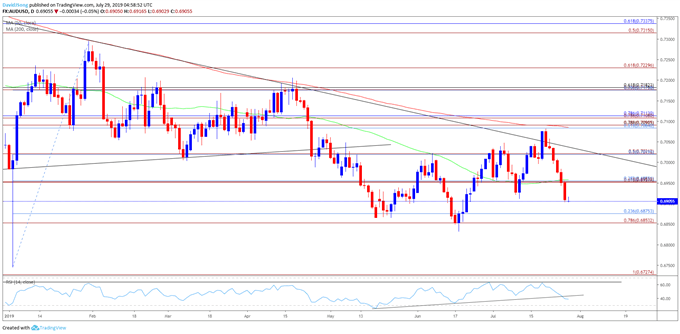Australian Dollar Talking Points
AUDUSD extends the decline from the previous week even though the US and China, Australia’s largest trading partner, make further attempts to reach a trad deal, and fresh developments coming out of the Asia/Pacific region may do little to shore up the Aussie Dollar exchange rate amid the weakening outlook for growth and inflation.
AUDUSD Carves Lower Highs and Lows After Being Capped by 200-Day SMA
AUDUSD stands at risk of exhibiting a more bearish behavior over the remainder of the month as the Reserve Bank of Australia (RBA) endorses a dovish forward guidance ahead of the next meeting on August 6.
It seems as though the RBA will continue to insulate the economy as Governor Lowe and Co. stand“prepared to provide additional support by easing monetary policy further,” and the central bank may continue to push the official cash rate (OCR) to fresh record lows as Governor Lowe insist that “it will be some time before inflation is comfortably back within the target range.”

Updates to Australia’s Consumer Price Index (CPI) may reinforce the RBA’s outlook even though the headline reading is projected to widen to 1.5% from 1.3% as the core rate of inflation is expected to narrow to 1.5% from 1.6% per annum in the first quarter of 2019.
A batch of mixed data prints is likely to drag on the Australian dollar, with AUDUSD at risk of giving back the rebound from the June-low (0.6832) as signs of below-target price growth puts pressure on the RBA to further embark on its rate easing cycle.
In turn, AUDUSD may extend the recent string of lower highs and lows ahead of the Federal Reserve interest rate decision on July 31, with the exchange rate at risk of facing a further decline as the advance from the June-low (0.6832) unravels ahead of the 200-Day SMA (0.7086).
Sign up and join DailyFX Currency Strategist David Song LIVE for an opportunity to discuss potential trade setups.
AUD/USD Rate Daily Chart

- Keep in mind, the broader outlook for AUDUSD remains tilted to the downside, with the exchange rate still at risk of giving back the rebound from the 2019-low (0.6745) as both price and the Relative Strength Index (RSI) continue to track the bearish formations from late last year.
- Moreover, the advance from the June-low (0.6832) has sputtered ahead of the Fibonacci overlap around 0.7080 (61.8% retracement) to 0.7110 (78.6% retracement), which lines up with the 200-Day SMA (0.7086), with AUDUSD carving a series of lower highs and lows.
- The break/close below the 0.6950 (61.8% expansion) to 0.6960 (38.2% retracement) region opens up the Fibonacci overlap around 0.6850 (78.6% expansion) to 0.6880 (23.6% retracement), with a break of the June-low (0.6832) raising the risk for a move towards 0.6730 (100% expansion).
Additional Trading Resources
Are you looking to improve your trading approach? Review the ‘Traits of a Successful Trader’ series on how to effectively use leverage along with other best practices that any trader can follow.
Want to know what other currency pairs the DailyFX team is watching? Download and review the Top Trading Opportunities for 2019.
--- Written by David Song, Currency Strategist
Follow me on Twitter at @DavidJSong.






